Given just how categorically weird Hideo Kojima’s games are, and how otherwise risk-averse AAA publishers tend to be, it is downright miraculous that Death Stranding was enough of a blockbuster hit for someone to greenlight a second one—even moreso since that’s a game where even the people who played it will give you one of those puppy dog tilted-head looks if you ask them what the plot was. Yes, there’s Norman Reedus; there’s a baby in a jar; Guillermo Del Toro’s in there somewhere; there’s a guy named after Die Hard for some reason; there’s a lot of squids and walking, and that’s all you can really expect. It’s a lot to try and make sense of. That’s not even to blame players or the modern attention span, that’s thoroughly by design—and Kojima knows it. Hideo saw how David Lynch stood on business, refusing at every turn to explain his art to anybody, and said “bet.” You love to see it.
But, the sequel has arrived, and just maybe some of you might want a nice handy primer on this wild story before dropping the money on Lone Daryl Dixon and Cub Volume 2. That’s no easy feat, given how plentiful but scattershot the lore is. But damn it, we’re gonna give it everything we’ve got to distill and streamline a hell of a lot of information and lore as much as possible. As long as this is gonna be, we cannot stress this enough: this is the short version. Strap in, kids, we’re going on a wild—and yes, spoilerful—ride.
The History of the (Other) World, Part I
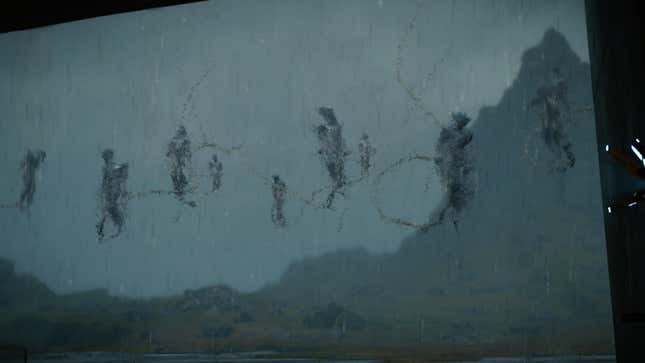
So, while this guide is going to attempt be as easy to parse as humanly possible, I’m sorry to say, we are gonna have to drop some absolute, pure, Grade A, metaphysical nonsense beforehand; there’s no way for this whole thing to make sense unless you have an idea of the basics.
Specifically, the basics of death.
In Death Stranding’s universe, there’s the world we all physically inhabit while we are alive—we all know the rules here, in theory—and then upon death, human souls pass through an area called the Beach. It’d be easy to describe the Beach as Purgatory, where the ocean is the true void of death and/or whatever comes after, but that’s not a full picture of Death Stranding’s conception of it. This “afterlife” is not dependent on morality, and not everybody’s Beach functions like a literal sand-filled beach (though many do, complete with dead sea creatures, especially when there’s mass death involved).
Functionally, think of The Beach as a one-way trip across the U.S./Canadian border, where the U.S. is life in the physical realm as we know it, and the great wolverine-infested wilderness of Northern Canada is death. The Beach is the checkpoint, the last look at America, all the duty-free shops, “last gas station before the border” signs, and some ridiculously tight security. In the normal world of Death Stranding, every person that dies has their soul take a drive up North, waits way too long in their car at the border, gets its passport checked out, and moves right along up North to join Alpha Flight or whatever people do up there. Canada, however, still has the big cities closer to the border, your Montreals, Torontos, Vancouvers, etc, before you get into the wilderness. They still feel familiar, but they can be extremely specific to the individual, and have their own rules outside the aforementioned. But instead of, say speaking French, or a crippling maple syrup addiction, the Beach mostly just throws out the normal rules of the flow of time, and is mostly made of antimatter. Still with us? Good.
Now, let’s assume someone breaks the rules, and sneaks a plate of poutine out of Canada into the U.S. without it being properly declared. Well, American politics being what they currently are, chances are good that person’s being shunted off to El Salvador. In Kojima’s world, however, the consequences are arguably even more severe, where any Canadian goods whatsoever winding up on the U.S. side of the border has a chance of triggering a nuclear bomb, the fallout of which affects both countries for years. More specifically to the world of the game: Any matter from the realm of the dead that winds up in the world of the living ends up wreaking total havoc with the natural order. And if that matter happens to be, say, a human soul trying to reinsert itself into its dead body, it triggers an explosion called a voidout, one big enough to completely wipe out a city in a split second, and punch a hole in both realms large enough for immigrants on both sides of the border to cross back and forth.
Tl;dr: the worlds of the living and the dead shouldn’t mix. And yet….
The Original Death Strandings
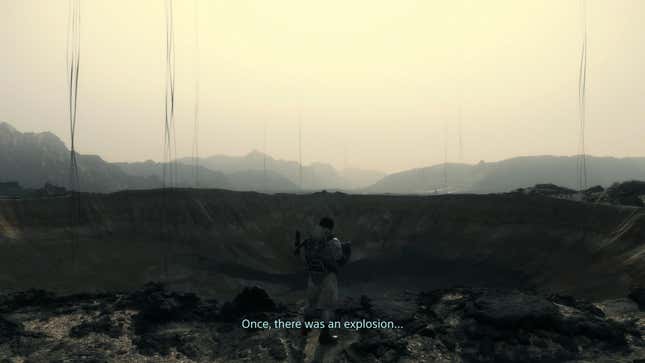
Now for the actual in-game history lesson: Every few million years or so, a being ends up tied so strongly to Earth and to their Beach that both sides eventually glitch out, and a Voidout so severe occurs that it triggers an Extinction Level Event (ELE). Specifically, the game infers that the Big Five ELEs—that bit of lingo’s 100% real, btw—were the result of that exact glitch in the fabric of reality, of so-called Extinction Entities coming into being. Evangelion fans: think Third Impact, and you have a rough idea what’s going on here, just no Angels involved, and the last one was caused by a Neanderthal, to give you an idea how long ago that was.
So, fast forward a few million years, humanity is evolved and thriving. At some point, an incident occurs in New York City where a woman has been pronounced braindead while she’s seven months pregnant. While they try to keep the mother on life support long enough for the baby to develop, when her vital signs start dropping, the obstetrician eventually makes the call to try and deliver the baby via C-section. Something about this whole situation doesn’t sit well with the laws of metaphysics, and during the procedure, the second the doctor tries to cut the umbilical cord, a voidout occurs, basically annihilating New York. The resulting tear blurs the borders between the realms of life and death enough for recently deceased humans to become potential voidout bait, and elements of the Beach—”Beached Things”, or BTs—to become stranded in our plane of existence, a phenomenon known as, drumroll, please, Death Stranding.
The (new) Manhattan Project

Following the destruction, the then-president of the United States orders a thorough investigation into what happened, which includes in a series of fucked-up secret experiments attempting to recreate the exact circumstances of the voidout—specifically breeding children called “Bridge Babies” in the wombs of braindead mothers, and observing their connection to the realm of the dead. The president is eventually killed in a voidout while observing one of those experiments, leaving the vice-president, Bridget Strand, in charge, finally giving America its first female president. By then, though, it kinda doesn’t matter. America is already in downright shambles after its greatest city gets merked, all sorts of unexplainable deadly antimatter phenomena start occurring across the country, making much of it uninhabitable. The chaos sends much of its population into quarantine to escape the worst of it, and social order completely breaks down after the people find out the government was getting its Unit 731 on with braindead women in the middle of it all. Google that one on your own time, and bring a stiff drink.
Bridget Strand, to her credit, is trying her best. She publicly orders the end of the experiments, and instead uses all of America’s resources to create an organization called Bridges. Their main goal is to try to give the cloistered pockets of America a way to stay connected and try to find a solution to this phenomenon while still remaining safe enough where no single BT event can have the effect it once did. She rebrands the country from the United States of America to the United Cities of America, and by using the antimatter (a.k.a. chiralium) of the Beach to power some new technology and protection measures, a sort of rudimentary, metaphysical internet now exists, known as the Chiral Network. Bridget is hailed by many as a hero.
The truth about Bridget Strand

All that, however, is what the public knew of President Strand. Behind the scenes, however, things are a wee bit more fucked up.
See, while the actual devastation began with the incident in Manhattan, Bridget Strand’s connection with the Beach began years prior. Bridget was diagnosed with uterine cancer in her 20s, and while undergoing an emergency procedure, she came close enough to death to find herself straddling the realms of this world and the next. Her physical body was successfully able to recover and function as normal on Earth. However, her soul, while somehow able to take shape in reality as well, was then permanently bound to the Beach, one of a few events that primes the two dimensions for what came later. Naming her phantom half Amelie, and explaining away her ageless appearances on Earth by branding her Bridget’s daughter, the two begin gathering information about the Beach and using government facilities to run experiments in secret for years before New York is destroyed. After the Manhattan voidout, however, and the chaos that ensues, Bridget already has the knowledge and infrastructure ready to build the protections humanity needs to endure, all while the strange phenomenon wracking the country gives her all the cover she needs to keep the truth about Amelie under wraps, and to keep running tests on Bridge Babies.
Le Fabuleux Destin d’Amelie Strand
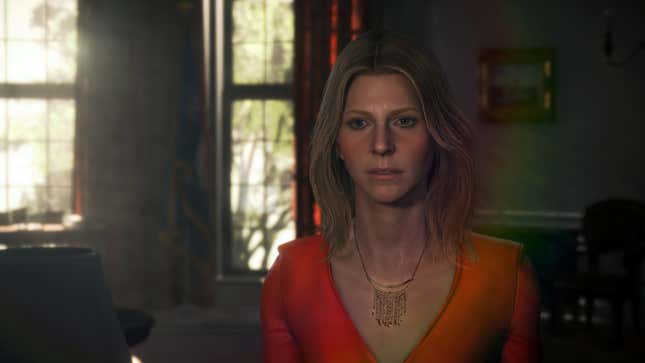
Oh, but wait, there’s more. During this period of research, Bridget starts having constant apocalyptic nightmares tied to Amelie, eventually determining that Amelie is, in fact, an Extinction Entity, and her very existence heralds the end of the world. The good news is that, in the cosmic sense, “the end is nigh” really means the end is hundreds of thousands of years away, which Bridget hopes will give humanity plenty of time to figure out a proper solution to the Death Stranding. That can only begin if humanity is able to communicate, share resources, knowledge, experience, and technology, though. Thus, Bridget spends the rest of her life trying to complete the Chiral Network.
Amelie, as an Extinction Entity, however, is less optimistic about those goals, seeing the next hundreds of thousands of years as painful, lonely, and hateful. She has other plans, ones that don’t involve her being isolated on the Beach twiddling her thumbs waiting for life to collapse. Her ultimate plan is to use the connections created by the Chiral Network to accelerate things, to create a Last Stranding big enough to end existence and the suffering of humanity in one shot. And she would’ve gotten away with it too, if not for that meddling Sam Porter-Bridges.
The Cliffs of Insanity
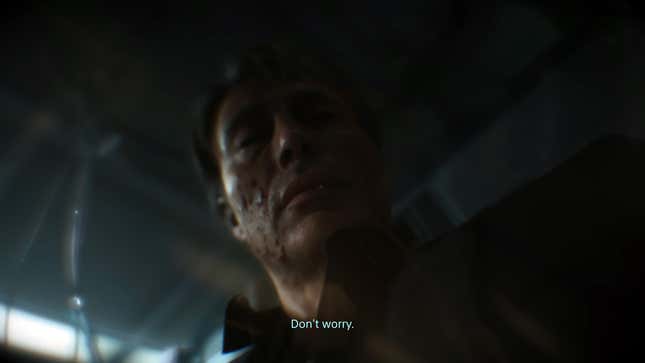
So, to tell the story of Sam Porter-Bridges, we need to talk about a dude named Cliff.
Cliff Unger is an Army Special Forces soldier, and a damn good one. Famously, no member of his squad ever got left behind, with one of his guys earning the nickname Die-Hardman because of how often Unger managed to save his ass in combat. Probably doesn’t hurt that his actual name is John Blake McClane. Look, nobody ever said Kojima was subtle. Either way, we’ll come back to him.
Cliff eventually gets his honorable discharge, and decides to start a family with his wife Lisa. However, the couple and their unborn son, B.B., get into a car accident. Cliff survives, but his wife is left braindead, and his son is in critical condition, and you can probably guess where that’s going. Desperate for solutions, Cliff eventually winds up pulling some strings and accepting an offer for some experimental treatments from his government, keeping his wife alive, and making a solemn attempt to save B.B. Cliff stays with the two of them as long as possible, obsessively talking to his wife and son when not becoming a full blown alcoholic. When it becomes obvious Cliff’s wife couldn’t be saved, the doctors decide to focus on salvaging B.B. for their burgeoning chiral research. What they don’t count on is somebody blabbing that fact to Cliff. That somebody, it turns out, is Die-Hardman.
While warning Cliff ahead of time that if he got an official order, he’d have to carry them out, Die-Hardman gives Cliff a window of time to mercy-kill Lisa, and get out of Dodge with B.B., who’s still developing in an artificial womb. The escape fails, with Bridget herself intervening to kill Cliff using Die-Hardman’s own gun when he hesitates from pulling the trigger himself. However, the shot doesn’t just kill Cliff, but B.B. Given that things on the other side of reality are already starting to get a little wonky, Cliff winds up trapped on his Beach—doomed to live in the collective unconscious nightmares of every single American war—desperately searching for his child on the other side. Meanwhile Amelie herself, recognizing the child as too valuable to her goals, intervenes on the Beach to send B.B. back to its body (a process called repatriation in-game). This is yet another major no-no that weakens the dimensional borders.
That small act of mercy does, however, have a few other unexpected effects. While the newly reborn B.B. is no longer viable as a Bridge Baby, one, he’s able to safely repatriate on his own should he ever find himself on the Beach, and two, Bridget, in genuine remorse for what happened to his parents, decides to officially adopt the poor kid, and give him a new name: Sam.
I am Sam; Sam I am
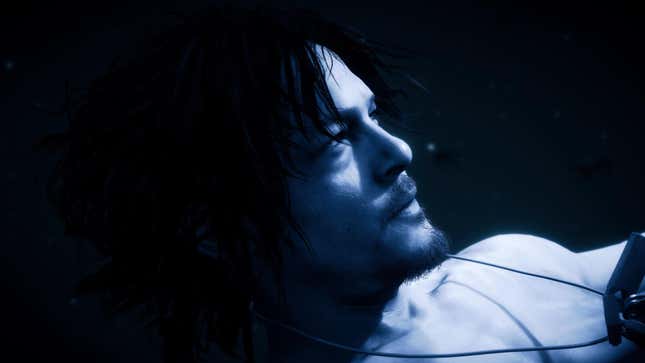
As one might expect, growing up in the time of the Death Stranding, Sam doesn’t exactly have an easy life, even as Bridget’s son. It doesn’t help that the poor kid has two pretty awful health conditions. One is aphenphosmphobia or haphephobia—a very real and legitimate fear of being touched. The other is DOOMS, which is, in short, a severe allergy to chiral matter that can manifest as uncontrollable tears and the ability to see BTs at best, and psychosis caused by connecting directly to the Beach in their dreams at worst. Sam is at least able to cope with that latter problem thanks to his big stepsister Amelie consistently stepping in to keep him calm whenever she finds him on the Beach, giving him a special necklace made of knots as a sort of anchor to the world of the living.
Still, Sam does grow up, eventually even joining Amelie and Bridges on their expeditions to reconnect the country. He even falls in love and gets married to a therapist named Lucy, originally assigned to help him with his phobia. Apparently, he gets over his phobia enough to get her pregnant with a little girl they plan to name Louise. That should be joyous, until Lucy finds out Sam has passed his DOOMS onto his unborn child, connecting Lucy to the Beach by proxy, and barraging her with horrible nightmares. The nightmares are, eventually, bad enough where Lucy commits suicide while Sam is off on a mission. Sam arrives home just in time to see his wife’s body, now gone necrotic with the unborn child, trigger a voidout. He, of course, is able to repatriate, but as the sole survivor of the voidout, rumors very quickly spread that he murdered his wife. The tragedy and the subsequent scandal, combined with his haphephobia returning with a vengeance, cause him to quit Bridges and disappear, changing his name to Sam Porter-Bridges, and has now fully isolated himself from what’s left of society.
Rebuilding Bridges
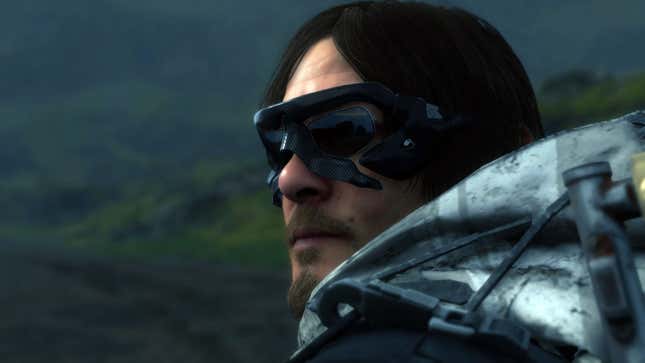
Sam spends the next 10 years as a freelance porter, basically what the post-Stranding world has instead of a postal service (though, those guys are still out there too, and—look, this thing is long enough). After a corpse disposal mission goes wrong, Sam is brought to a Bridges outpost by a government doctor/mortician named Deadman, and given a very special delivery mission: bringing morphine to a nearby facility where Bridget is on her deathbed, being watched over by a very promoted Die-Hardman.
While the two don’t exactly reconcile, Bridget does try to convince Sam to take the journey west and finish her mission of reconnecting the cities to the chiral network. Sam refuses before she dies. However, when Amelie asks, she gets to play the sympathy card, telling him that a terrorist group named Homo Demens took her hostage when she reached the West Coast—naturally, obscuring her actual end goal when she gets free. Still feeling some sense of obligation to his sister, Sam actually agrees.
And so, with a necklace of chiral hard drives with all the software to get any outpost on the network, Sam sets off to finish Bridget and Amelie’s work. Herein, the brunt of Death Stranding’s action takes place, with Sam making copious deliveries, hearing stories all across the derelict, blackened landscapes of America, making new friends—such as fellow DOOMS-afflicted porter Fragile, and Deadman, who becomes Sam’s man-in-the-chair for most of his mission. He also makes some asshole enemies—specifically, Higgs Monaghan, the psychotic leader of Homo Demens, violently committed to keeping the West Coast independent of the rest of the United Cities of America by any means necessary. And, of course, Sam ends up having a lot of run-ins with BTs. This is the stuff you can get from a Wikipedia entry. There is, however, one particularly special friend worth addressing….
Sweet Child O’ Mine
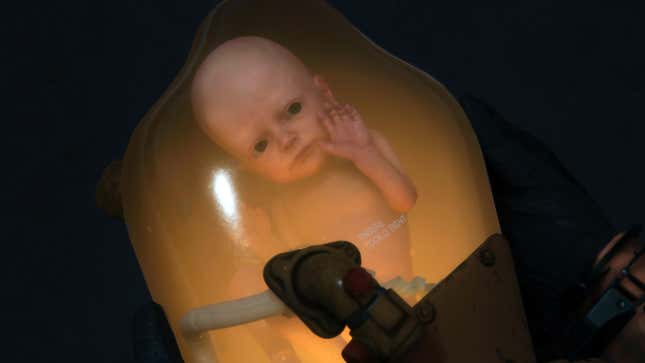
So, in the intervening years since the Death Stranding, Bridges does, in fact, manage to find a use for all the Bridge Babies they pumped out: Since the poor things are partially connected to the Beach, they’re able to actually sense BTs. Thus, anyone who goes outside on Bridges business takes one with them, contained in a special capsule meant to simulate a braindead mother’s womb, at least until their abilities wane and they must be disposed of (if the baby gets too acclimated to the world of the living, it can create a voidout). That’s a lot of really fucked up experimentation to produce the world’s most elaborate early-warning system, but whatcha gonna do?
Either way, during Sam’s delivery-gone-wrong, he inherits a Bridge Baby from one of the soldiers who went with him who died in the subsequent voidout. Connecting to this bridge baby triggers visions of Cliff Unger in Sam, occasionally even dragging Sam into Cliff’s Beach as Cliff mistakes Sam’s Beach Baby for his own, not realizing (yet) that Sam is his son. For his part, however, even though people aren’t meant to get too attached to their bridge babies, Sam can’t help but form a bond, eventually coming to name the baby Lou—his dead daughter’s nickname. In return, Lou finds herself using her connection to the Beach much more often to keep Sam safe.
The West Coast and the Last Stranding
Once Sam reaches the West Coast, he and Higgs end up having a few chats over tea and punching, with Higgs informing him about Amelie being an Extinction Entity, and the fact Amelie gave Higgs a tiny Whitman’s sampler platter of her powers over the Beach to become her “agent of extinction” on Earth. While he manages to neutralize Higgs (thanks to an assist from fellow porter Fragile), and fully connect the network, he is told to make his way back East. Die-Hardman gives Sam a call to tell him about Cliff, Bridget, and Amelie’s original plans, and it ends in Fragile using her teleportation powers and connection to the Beach (look, like i said, long story) to bring Sam to Amelie.
Amelie doesn’t try to hide, and offers Sam a choice: let her finish her work, so the Extinction can happen as humanely as possible or shoot her fully dead and sever her from the world of the living permanently. Sam chooses…neither. He recognizes her plans as an act of desperation in the face of an eternal loneliness beyond measure. And he embraces her as a sister. The extinction can’t be stopped, but it can be postponed, allowed to occur when hopefully life has an opportunity to come out of it stronger than before, just as it did the previous five times. And so, Amelie pushes Sam back to Earth, and chooses to remain at the Beach, alone, to give life its chance.
The last delivery
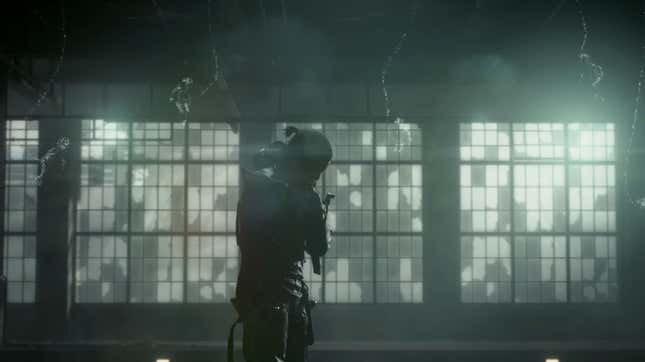
When Sam gets back, he discovers a month has passed. Die-Hardman has been sworn in as the new UCA president, which is great news. The bad news: Lou has been separated from Sam for too long, and on Die-Hardman’s orders, has to be decommissioned. That is, destroyed. However, Deadman suggests, as yet another experiment, that instead of just dropping Lou in an incinerator that he should separate her from the artificial womb container, and “see what happens.” While Lou initially is unresponsive to Sam’s efforts to revive her, BTs of the other lost bridge babies appear around them, and Lou actually sputters to life, holding one of Amelie’s knotted necklaces, implying that Amelie kept Lou out of the Beach. Big sis is apparently still looking out for the family, and Sam walks off into the sunset to, presumably, raise his daughter in peace.
Now that you’re all caught up, it’s time to jump into the epic sequel that is Death Stranding 2.
